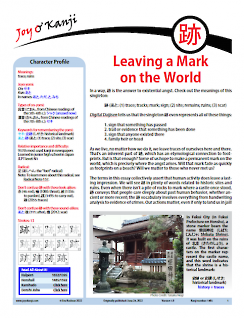跡
trace; ruins
Kanji 1485
Thank you for visiting this Character Home Page. Below you'll find a synopsis of the essay. If you wish to read the full text, the PDF of the essay is available for purchase to the right.
Discover why Sun Yat-sen’s handwriting mattered to the Japanese, and find out how they feel about the look of razor stubble and harvested fields. Also see why a Nagoya well contained gold, how ruins relate to one generation, and what “crow footprints” represent. Learn to say, “We found footprints in the sand,” “There is no sign of life on Mars,” and “Each era has left its mark.”
Revision history:
Nov. 26, 2024: p. 16: Parenthesized "Camera" in the book title.
Dec. 5, 2023: p. 5: Fixed a missing hyphen.
Aug. 18, 2023: p. 10, photo caption: My proofreader feels that the yomi of 国指定 is likely くにしてい, not こくしてい, so I have made that change.
Sept. 10, 2022: p. 16: Changed the end of the sample sentence from あった to ある。
June 25, 2022: Originally published.



Comments